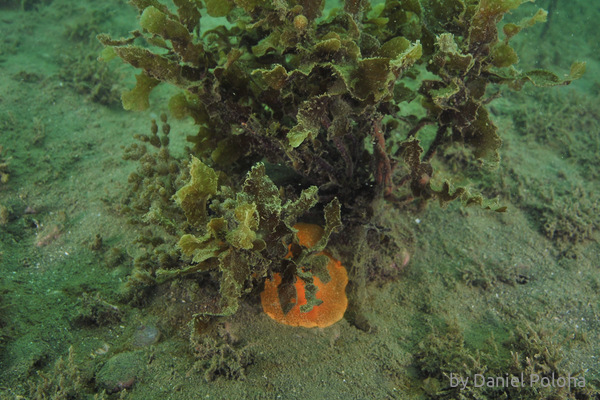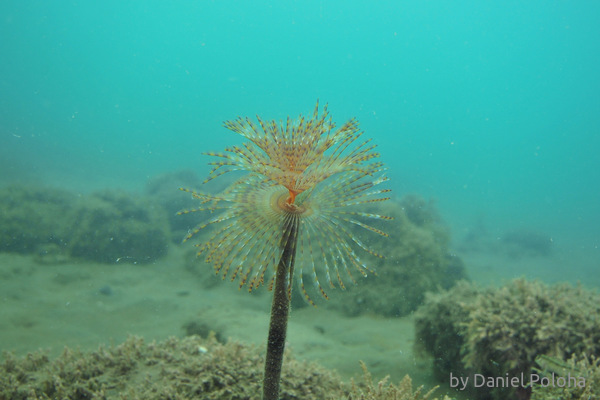Mahurangi Harbour After Stormy Weather
18/3/2017 (616)
I went to Mahurangi Harbour to see the results of the stormy weather and floods from a week ago. I dive in the harbour mostly for nostalgic reasons, but also for surprises. On a good day there can be plenty of usual nudibranches, sea hares there; I saw seahorses, rare nudibranches and a sunken tree covered with red soft corals in the harbour too. Unfortunately it is getting infested with marine pests and is choking from all the sediments getting into it from the surrounding farmlands. Otherwise it would make a great place for muck diving … I am talking about the mouth of the harbour near Pudding Island.
Anyway, I went there to see what had happened. I came a bit late, right after the high tide. The outgoing tide was already running which affected visibility. I was more concerned about the fact I could see some quite big sponges rotting in the sand. Other that that a usual stuff. Plus one nice octopus, but it was not in a mood to play. Also for an unknown reason there were fewer Mediterranean fan worms in Sullivans (Otarawao) Bay than recently which was a good news I think.
Slovak
Šiel som do Mahurangi Harbour zistiť, čo napáhcala búrka a záplavy z minulého týždňa. Je to chránený prírodný prístav, potápam sa tam z nostalgických dôvodov, ale aj kvôli častým prekvapeniam. Keď sú dobré podmienky, je tam veľa na NZ bežných nahožiabrých slimákov a morských zajacov (hlavne takých chlpatých). Okrem toho som tam videl aj morských koníkov, veľmi zriedkavých slimákov a potopený strom pokrytý mäkkými červenými koralmi. Nanešťastie sa v prístave množia zavlečené živočíchy a celý sa dusí pod sedimentmi naplavenými z okolitých fariem. Inak by to bolo skvelé miesto pre “muck” potápanie … mám teraz na mysli konkrétne oblasť okolo Pudingového ostrova.
Takže ma zaujímalo, čo počasie narobilo pod vodou. Prišiel som trochu neskoro, už bolo po vrchole prílivu. Rozbiehal sa odliv, čo dosť poznačilo viditeľnosť, inak slabú aj za lepších podmienok. Viac starostí mi robilo to, že po dne boli pováľané dosť veľké huby … búrka ich musela odtrhnúť od skál. Inak to bol štandard. Navyše som videl aj peknú chobotnicu, ale nechcelo sa jej hrať. Z mne neznámych dôvodov som videl menej stredomorských červov Sabella spallanzanii než zvyčajne, čo je podľa mňa celkom dobrá správa.

Small schools of spotties among sea weeds covered with fine sediment. Visivility is quite sad, partially due to the outgoing tide, but also because of the overall conditions in the harbour.

A large area of bright yellow boring sponge. The are is actually more than 2m long. They used be more frequent (I think) on the flat reef in Sullivans Bay, but they are too often buried in sediment now.

Large dead horse mussel on flat muddy bottom provides solid base for encrusting life forms.

Frond of brown kelp Ecklonia radiata torn off rocky bottom rotting slowly on muddy bottom.

Contrast of colour and shape – a brightly coloured nipple sponge on muddy sediment hiding flat rocky reef.

Partially translucent large lemon nudibranch hiding under a bush of algae.

Tunicates on the flat bottom – both the native (the smaller ones) and the invasive (the bigger club tunicates) species.

Common sea urching Evechinus chloroticus in the open of flat rock partially covered with silt. I hope it does not ‘think’ that tiny shell provides enough protection or camouflage.

Inflated cushion sea star – its cousins, common cushion sea stars, often look like ‘mud’. I mean their colour is very similar to the mud they often live on. Their relative (on the picture) is completely different, visible from a distance.


A tiny piece of colourful reef – green algae on the top, colourful sponges on the walls and under overhangs. It sounds like nothing special, but this micro reef exists in the area where mud rules.

Octopus hiding among rocks. It was not in the mood to play and I had nothing interesting enough to get it attracted.

Mediterranean fan worms are beautiful, but should not live in New Zealand coastal waters. I was happy I could not see too many of them during my last dive in Mahurangi Harbour.